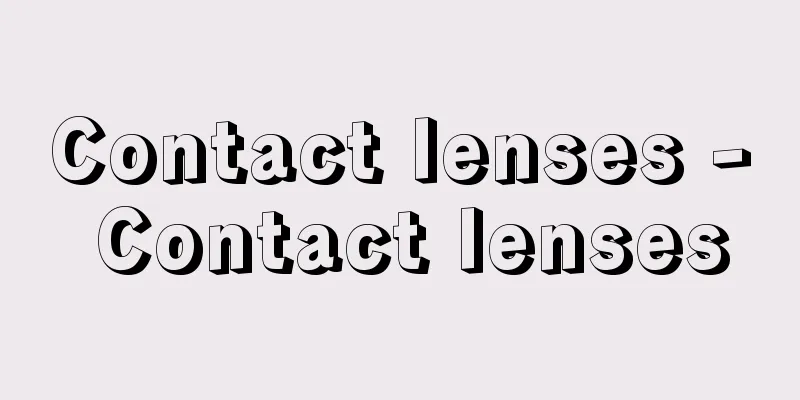Contact lenses - Contact lenses

|
A small, thin lens that is placed in close contact with the eyeball to correct refractive errors, it has been used since the end of the 19th century. Initially, they were made of glass, with plastic lenses appearing after the 1930s. Hard contact lenses are generally dish-shaped plastic lenses with a diameter of 8-9 mm and a thickness of 0.1-0.3 mm, and are worn directly on the cornea, utilizing the surface tension of tears. Contact lenses are used for severe myopia, hyperopia, astigmatism, conic cornea, anisometropia (a large difference in refractive power between the left and right eyes), and after cataract surgery, which are difficult to correct with glasses. In addition, contact lenses are now often worn for cosmetic, professional, and sports reasons. People with eye inflammation such as conjunctivitis, keratitis, and dacryocystitis should avoid wearing contact lenses. The advantages of contact lenses include the fact that they can be used in cases where correction with glasses is difficult, that they have a wide field of vision and are less likely to cloud up, and that it is difficult to tell that you are wearing them. However, contact lenses also have disadvantages. Compared to glasses, they are more troublesome to handle and easier to lose. In addition, since a large foreign object is placed in the eye, practice is required when using them for the first time, and various symptoms appear until you get used to them. In addition, they are easy to damage the cornea, and if you do not notice a scratch on the cornea while wearing them, or if you force them in or use them irregularly, bacteria may infect the cornea and cause a corneal ulcer. In any case, contact lens wearers are advised to have regular checkups at least once every three months for lens distortion, changes in the cornea, changes in refraction, etc. If you wear contact lenses irregularly or sleep with them on, you may suffer from severe pain, so if you experience eye pain or a different feeling from usual while wearing them, you should immediately have your eyes examined by an ophthalmologist. Hard contact lenses are made of a hard material, and they fit closely to the cornea. Blinking or eye movement causes the lens to move, which replaces tears and supplies oxygen to the cornea. In contrast, soft contact lenses are soft, with a water content of about 40-80%, and allow oxygen to pass through. They are more comfortable to wear than hard contact lenses, can be worn for long periods of time, and require less practice, but they are prone to deformation, so vision correction can sometimes be unstable. Also, because they are soft, they do not last long, with a lifespan of about two years. The most important thing to be careful of is that they are prone to mold and bacteria, so they need to be washed thoroughly every day and boiled for disinfection once every few days, making them somewhat difficult to care for. In addition, even if the cornea is scratched, the pain is milder than with hard contact lenses, so by the time you notice it, it may be too late. In recent years, continuous use of soft contact lenses has become possible, and disposable contact lenses (which are replaced with new lenses every day or every two weeks) have also become widespread, making it possible to wear them for long periods of time without problems, especially after cataract surgery or in cases of dry keratoconjunctivitis with reduced tear production. When wearing soft contact lenses, regular checkups are also required more frequently than for hard contact lenses. Approximately once a month is necessary. If you are getting contact lenses for the first time, you should see an ophthalmologist who specializes in contact lenses, and after a thorough consultation about the suitability of contact lenses and any precautions you should take, have your refractive power and corneal curve measured and get a prescription. It is also important to decide on an ophthalmologist who can examine you immediately if you experience pain or any other abnormalities. [Akira Nakajima] "How to Choose Contact Lenses Without Making a Mistake" by Hisao Magatani (CBS/Sony Books) [Reference] | |Source: Shogakukan Encyclopedia Nipponica About Encyclopedia Nipponica Information | Legend |
|
眼球に密着(コンタクト)させて目の屈折異常を矯正する小さくて薄いレンズで、19世紀末から使われ始めた。最初はガラス製で、1930年以降にプラスチック製のものが出現した。一般に、ハードコンタクトレンズは直径8~9ミリメートル、厚さ0.1~0.3ミリメートルくらいの皿状をしたプラスチックのレンズで、角膜に涙の表面張力を利用して直接装用する。 コンタクトレンズは、強度の近視、遠視、乱視、円錐(えんすい)角膜のほか、左右の目の屈折力に大きな差がある不同視、あるいは白内障の手術後など、眼鏡では矯正のむずかしい場合のほか、現在では美容、職業、スポーツなどの関係で装用されることも多くなっている。結膜炎、角膜炎、涙嚢(るいのう)炎など、目に炎症のある人などの場合は、コンタクトレンズの装用は避けなければならない。コンタクトレンズの長所としては、眼鏡での矯正のむずかしい場合に使用できること、視野が広くて曇りにくいこと、装用していることがわかりにくいことなどがあげられる。しかしコンタクトレンズにも欠点がある。眼鏡に比べて取扱いがめんどうで、紛失しやすい。また、目の中に大きな異物を入れるわけであり、初めて使うときは練習が必要で、慣れるまで種々の症状が出現する。さらに、角膜を傷つけやすく、装用中に角膜の傷に気がつかなかったり、無理に入れたり不規則な使い方をすると、細菌が感染して角膜潰瘍(かいよう)になることもある。いずれにしても、コンタクトレンズを装用している人は、レンズのひずみや角膜の変化、屈折度の変化などについて、少なくとも3か月に1回の定期検査が望ましい。なお、装用の仕方が不規則であったり、装用したまま眠ったりすることで激痛に悩まされることもあり、装用中に目の痛みなどがあったり、いつもと装用感が異なったりした場合には、すぐに眼科専門医の検査を受ける必要がある。 ハードコンタクトレンズは材質が硬く、角膜に密着して、まばたきや目の動きによってレンズが動き、そのために涙が入れ替わり、角膜への酸素供給が行われる。これに対してソフトコンタクトレンズは、含水率が40~80%くらいで軟らかく、酸素を透過させる。装用感はハードコンタクトレンズよりもよくて長時間装用できるし、練習も少なくてすむが、変形しやすいので視力の矯正がときに不安定になることがある。また、軟らかいために、もちが悪く、寿命は約2年くらいである。なお、もっとも注意しなければならないことは、カビや細菌がつきやすく、毎日きれいに洗ったり、煮沸消毒も何日かに1回は必要で、管理がややたいへんなことである。そのほか、角膜に傷がついても痛みがハードコンタクトレンズに比べて軽いため、気づいたときは手遅れになる場合もある。近年はソフトコンタクトレンズの連続装用が可能になり、使い捨てコンタクトレンズ(毎日、あるいは2週間ごとに新しいレンズに取り替える)も普及して、とくに白内障の手術後や涙液の減少した乾性角結膜炎に長期間、問題もなく装用していられるようになってきた。ソフトコンタクトレンズ装用の場合は、ハードコンタクトレンズに比較して定期検査も多くする。月に1回くらいは必要である。 なお、初めてコンタクトレンズをつくる場合は、コンタクトレンズを扱っている眼科で診察を受け、コンタクトレンズ装用の適応や注意すべき事項について十分に相談のうえ、屈折の度と角膜のカーブを測って処方をしてもらう。また、痛くなったり、異常を認めたときにすぐ診てもらえる眼科を決めておくことも必要である。 [中島 章] 『曲谷久雄著『失敗しないコンタクトレンズ選び』(CBS・ソニーブックス)』 [参照項目] | |出典 小学館 日本大百科全書(ニッポニカ)日本大百科全書(ニッポニカ)について 情報 | 凡例 |
<<: Turbidity current - kondakuryu (English spelling)
>>: Conductance - kondakutansu (English spelling) conductance
Recommend
qaṣr (English spelling) qasr
…(4) Tombs (qubba, gunbad, türbe, mashhad): These...
La Parisienne (English spelling)
…But this work was also criticized as being too g...
Wager, LR - Wager
...For this reason, Bowen's theory was though...
Rice - Gyobei
…[Morita Tatsuyoshi] In China, it is written as p...
Alpine Salamandra - Alps Salamandra
... Among newts, the genus Tylototriton , found i...
Viennese Classicism - Vienna Kotenha
A general term for classical composers who were ac...
Myomokusho
This dictionary was compiled by the Left Minister ...
Beans - beans
In the past, it referred to soybeans, but now it ...
Idiot - Hakuchi
(Original title, Russian: Idiot ) A full-length no...
HPNS - Hpns
…(4) Disorders associated with pressurization and...
Persephone (English spelling)
A goddess in Greek mythology. Her Latin name is Pr...
Theatre - Engeki
It is a form of art expressed through words and g...
East St. Louis
...Population: 368,000 (1994), metropolitan area ...
Etiol - Etiol
…Reindeer bones are by far the most common, but b...
Kazakh people - Kazakh (English spelling)
A Turkic ethnic group whose main habitat is the Re...

![Ten Kings [Town] - Juou](/upload/images/67cbd1556724e.webp)







